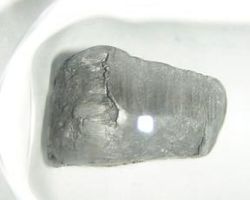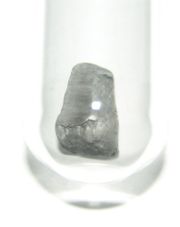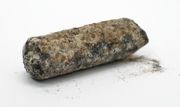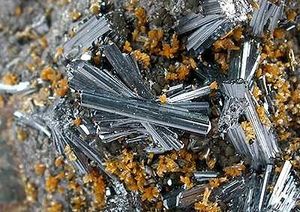ثاليوم
| ||||||||||||||||||||||||||||
| المظهر | ||||||||||||||||||||||||||||
|---|---|---|---|---|---|---|---|---|---|---|---|---|---|---|---|---|---|---|---|---|---|---|---|---|---|---|---|---|
أبيض فضي
| ||||||||||||||||||||||||||||
| الخصائص العامة | ||||||||||||||||||||||||||||
| الاسم، الرمز، الرقم | ثاليوم, Tl, 81 | |||||||||||||||||||||||||||
| النطق | /ˈθæliəm/ THAL-ee-əm | |||||||||||||||||||||||||||
| تصنيف العنصر | فلز بعد انتقالي | |||||||||||||||||||||||||||
| المجموعة، الدورة، المستوى الفرعي | 13, 6, p | |||||||||||||||||||||||||||
| الوزن الذري القياسي | 204.3833 | |||||||||||||||||||||||||||
| التوزيع الإلكتروني | [Xe] 4f14 5d10 6s2 6p1 2, 8, 18, 32, 18, 3 | |||||||||||||||||||||||||||
| الخصائص الطبيعية | ||||||||||||||||||||||||||||
| الطور | solid | |||||||||||||||||||||||||||
| الكثافة (بالقرب من د.ح.غ.) | 11.85 g·cm−3 | |||||||||||||||||||||||||||
| الكثافة السائلة عند ن.إ. | 11.22 گ·سم−3 | |||||||||||||||||||||||||||
| نقطة الانصهار | 577 ك, 304 °C, 579 °F | |||||||||||||||||||||||||||
| نقطة الغليان | 1746 ك, 1473 °س, 2683 °ف | |||||||||||||||||||||||||||
| حرارة الانصهار | 4.14 كج·مول−1 | |||||||||||||||||||||||||||
| حرارة التبخر | 165 كج·مول−1 | |||||||||||||||||||||||||||
| السعة الحرارية المولية | 26.32 ج·مول−1·ك−1 | |||||||||||||||||||||||||||
| ضغط البخار | ||||||||||||||||||||||||||||
| ||||||||||||||||||||||||||||
| الخصائص الذرية | ||||||||||||||||||||||||||||
| حالات الأكسدة | 3, 1 (أكسيد قاعدي باعتدال) | |||||||||||||||||||||||||||
| سالبية كهربية | 1.62 (مقياس پولنگ) | |||||||||||||||||||||||||||
| طاقات التأين | الأولى: 589.4 كج·مول−1 | |||||||||||||||||||||||||||
| الثانية: 1971 كج·مول−1 | ||||||||||||||||||||||||||||
| الثالثة: 2878 كج·مول−1 | ||||||||||||||||||||||||||||
| نصف القطر الذري | 170 پم | |||||||||||||||||||||||||||
| نصف قطر تساهمي | 170±8 pm | |||||||||||||||||||||||||||
| نصف قطر ڤان در ڤالز | 196 pm | |||||||||||||||||||||||||||
| متفرقات | ||||||||||||||||||||||||||||
| البنية البلورية | hexagonal | |||||||||||||||||||||||||||
| الترتيب المغناطيسي | diamagnetic[1] | |||||||||||||||||||||||||||
| المقاومية الكهربائية | (20 °C) 0.18 µΩ·m | |||||||||||||||||||||||||||
| ناقلية حرارية | 46.1 W·m−1·K−1 | |||||||||||||||||||||||||||
| التمدد الحراري | (25 °س) 29.9 µm·م−1·ك−1 | |||||||||||||||||||||||||||
| سرعة الصوت (قضيب رفيع) | (20 °س) 818 م·ث−1 | |||||||||||||||||||||||||||
| معامل ينگ | 8 گپا | |||||||||||||||||||||||||||
| معامل القص | 2.8 گپا | |||||||||||||||||||||||||||
| معامل الحجم | 43 گپا | |||||||||||||||||||||||||||
| نسبة پواسون | 0.45 | |||||||||||||||||||||||||||
| صلادة موس | 1.2 | |||||||||||||||||||||||||||
| صلادة برينل | 26.4 مپا | |||||||||||||||||||||||||||
| رقم تسجيل كاس | 7440-28-0 | |||||||||||||||||||||||||||
| أكثر النظائر استقراراً | ||||||||||||||||||||||||||||
| المقالة الرئيسية: نظائر ثاليوم | ||||||||||||||||||||||||||||
| ||||||||||||||||||||||||||||
الثاليوم Thallium (IPA: /ˈθaliəm/) عنصر كيميائي في الجدول الدوري وله الرمز Tl ورقم ذري 81.[2] هذا الفلز الفقير القابل للتشكيل والرمادي الطري يشبه القصدير إلى أنه يتبقع عندما يتعرض للهواء. الثاليوم شديد السمية ويستعمل في سم الفئران والمبيدات الحشرية ولكن لاحتمال تسببه في السرطان (بالرغم من أن وكالة الحماية البيئية الأمريكية لا تصنفه كمسرطن)، هذا الاستخدام قد انخفض بشدة أو ألغي في العديد من الدول. ويستخدم أيضاً في مجسات الآشعة تحت الحمراء.[3] بل إنه قد استـُخدِم في بعض عمليات القتل، مما أكسبه الكـُنى "السم المفضل للمتخصص في التسميم" و "مسحوق الميراث" (بجانب الزرنيخ).
الثليوم عنصر كيميائي رمزه الكيميائي Tm. وهو واحد من عناصر الأتربة النادرة. وعدده الذري 69، ووزنه الذري 168,934. اكتشف العالم السويدي بيركليف الثليوم عام 1879م. يوجد الثليوم مع الأتربة النادرة الأخرى في معدن الجادولينيت، والأكسينيت، والزينوتيم، وغيرها. وأفضل الطرق لعزل الثليوم عن عناصر الأتربة الأخرى، هي عملية التبادل الأيوني، أو الاستخلاص بالمذيب. ينصهر الثاليوم في درجة حرارة 1,545°م، ويغلي في درجة حرارة 1,950°م، وكثافته 9,318جم/سم² عند درجة حرارة 25°م. يستخدم الثليوم المشع في وحدات الأشعة السينية المتنقلة. ومثل هذه الوحدات لا تحتاج إلى معدات كهربائية، بل تحتاج فقط إلى إعادة شحن بالثليوم، مرة واحدة فقط كل بضعة أشهر.
. . . . . . . . . . . . . . . . . . . . . . . . . . . . . . . . . . . . . . . . . . . . . . . . . . . . . . . . . . . . . . . . . . . . . . . . . . . . . . . . . . . . . . . . . . . . . . . . . . . . . . . . . . . . . . . . . . . . . . . . . . . . . . . . . . . . . . . . . . . . . . . . . . . . . . . . . . . . . . . . . . . . . . . .
السمات المميزة
النظائر
الكيمياء
التاريخ
ثاليوم (باليونانية [θαλλός] Error: {{Lang}}: text has italic markup (help)، [thallos] Error: {{Lang}}: text has italic markup (help)، تعني "غصن أخضر")[4] اُكتـُشِف بمطيافية اللهب في 1861.[5] الاسم يأتي من خطوط الانبعاث الطيفية الخضراء للثاليوم.[6]
بعد نشر الطريقة المنقحة لمطيافية اللهب من قِبل روبرت بونزن وگوستاف كيرشوف[7] واكتشاف السيزيوم والروبيديوم في السنتين 1859 إلى 1860، أصبحت مطيافية اللهب طريقة مقبولة لتحديد مكونات المعادن والمواد الكيميائية. بدأ كل من وليام كروكس وكلود-أوگوست لامي في استخدام الطريقة الجديدة. وقد استخدمها وليام كروكس ليقوم بتحديدات طيفية للتلوريوم في مركبات السلنيوم المترسبة في lead chamber في مصنع لانتاج حمض الكبريتيك بالقرب من تيلكرود في جبال هارتس. وكان قد حصل على العينات لأبحاثه في سيانيد السلنيوم من أوگوست هوفمان قبل ذلك بأعوام.[8][9] وبحلول 1862، تمكن كروكس من عزل كميات صغيرة من العنصر الجديد وتحديد خصائص بعض المركبات.[10] استخدم كلود-أوگوست لامي مطياف مشابه لمطياف كروكس لتحديد تركيب مادة محتوية على السلنيوم، ترسبت أثناء انتاج حمض الكبريتيك من الپيريت. كما لاحظ الخط الأخضر الجديد في الأطياف واستنتج أن عنصراً جديداً كان موجوداً. وقد تسلم لامي هذه المادة من مصنع حمض الكبريتيك الذي يملكه صديقه فريد كولمان وكان هذا الناتج الجانبي متوافراً بكميات كبيرة. بدأ لامي في عزل العنصر الجديد من هذا المصدر.[11] وحقيقة أن لامي كان قادراً على العمل على كميات وفيرة من الثاليوم مكـَّنه من تحديد خصائص مركبات عديدة وبالاضافة لذلك فقد أعد سبيكة صغيرة من الثاليوم الفلزي حضـَّرها بالتحليل الكهربائي لأملاح الثاليوم.
التواجد والإنتاج
التطبيقات
الاستخدامات التاريخية
The odorless and tasteless thallium sulfate was once widely used as rat poison and ant killer. Since 1972 this use has been prohibited in the الولايات المتحدة due to safety concerns.[12] Many other countries followed this example in the following years.[13] Thallium salts were used in the treatment of ringworm, other skin infections and to reduce the night sweating of tuberculosis patents. However this use has been limited due to their narrow therapeutic index, and the development of more-advanced medicines for these conditions.[14][15][16]
البصريات
Thallium(I) bromide and thallium(I) iodide crystals have been used as infrared optical materials, because they are harder than other common infrared optics, and because they have transmission at significantly longer wavelengths. The trade name KRS-5 refers to this material.[17] Thallium oxide has been used to manufacture glasses that have a high index of refraction. Combined with sulfur or selenium and arsenic, thallium has been used in the production of high-density glasses that have low melting points in the range of 125 and 150 °C. These glasses have room temperature properties that are similar to ordinary glasses and are durable, insoluble in water and have unique refractive indices.[18]
الإلكترونيات
الموصلية الكهربائية لكبريتيدات الثاليوم الأحادي تتغير بالتعرض لضوء آشعة تحت الحمراء وهو ما يجعل هذا المركب مفيداً في photoresistors.[14] وقد اُستخدم سلنيد الثاليوم في بولومتر للكشف عن الآشعة تحت الحمراء.[19] Doping أشباه موصلات السلنيوم يالثاليوم يحسن أداءهم، ولذلك يستخدَم بكميات ضئيلة جداً في مقومات السلنيوم.[14] واستخدام آخر للغمس في الثاليوم هو بلورات يوديد الصوديوم في أجهزة الكشف عن اشعاع گاما. وفي هؤلاء، فإن بلورات يوديد الصوديوم are doped بكمية صغيرة من الثاليوم لتحسين كفاءتهم كمولدات scintillation.[20] بعض الأقطاب الكهربائية في محللات الأكسجين المذاب تحتوي على الثاليوم.[13]
الموصلية الفائقة عند درجات الحرارة العالية
الاستخدامات الطبية
Before the widespread application of technetium-99m in nuclear medicine, the radioactive isotope thallium-201, with a half-life of 73 hours, was the main substance for nuclear diagnostics. The nuclide is still used for stress tests for risk stratification in patients with coronary artery disease (CAD).[21] This isotope of thallium can be generated using a transportable generator which is similar to the technetium cow.[22] The generator contains lead-201 (half life 9.33 hours) which decays by electron capture to the thallium-201. The lead-201 can be produced in a cyclotron by the bombardment of thallium with protons or deuterons by the (p,3n) and (d,4n) reactions.[23][24]
اختبار المجهود بالثاليوم
A thallium stress test is a form of scintigraphy, where amount of thallium in tissues correlates with tissue blood supply. Viable cardiac cells have normal Na+/K+ ion exchange pumps. Thallium binds the K+ pumps and is transported into the cells. Exercise or dipyridamole induces widening (vasodilation) of normal coronary arteries. This produces coronary steal from areas where arteries are maximally dilated. Areas of infarct or ischemic tissue will remain "cold". Pre- and post-stress thallium may indicated areas which will benefit from myocardial revascularization. Redistribution indicates the existence of coronary steal and the presence of ischemic coronary artery disease.[25]
. . . . . . . . . . . . . . . . . . . . . . . . . . . . . . . . . . . . . . . . . . . . . . . . . . . . . . . . . . . . . . . . . . . . . . . . . . . . . . . . . . . . . . . . . . . . . . . . . . . . . . . . . . . . . . . . . . . . . . . . . . . . . . . . . . . . . . . . . . . . . . . . . . . . . . . . . . . . . . . . . . . . . . . .
استخدامات أخرى
السمية
الثاليوم ومركباته شديدو السمية، ويجب تداولهم بحذر كبير. واتصاله بالبشرة خطير، ويجب توفير تهوية مناسبة أثناء صهر هذا الفلز. مركبات الثاليوم (الأحادي) لها قابلية عالية للذوبان في الماء ويتم امتصاصها بسرعة عبر مسام الجلد. والتعرض لهم يجب ألا يتعدى 0.1 مج لكل م2 من البشرة في متوسط موزَّع لفترة طولها 8-ساعات (لأسبوع عمل طوله 40-ساعة عمل). ويـُعتقد أن الثاليوم مسرطن للبشر.[26] لزمن طويل كانت مركبات الثاليوم متوافرة كسم فئران. هذه الحقيقة بالاضافة لكونه سهل الذوبان في الماء وكونه عديم الطعم أدى إلى حالات تسمم متعددة غير مقصودة أو مقصودة إجرامياً.[27]
وفي 10 يناير 2011، اتهم بسام أبو شريف، مساعد أبي عمار، إسرائيل بإغتيال ياسر عرفات باستخدام الثاليوم. وقال أن لديه تقريراً من كبير خبراء السموم الجنائية بإنجلترة، دون ذكر اسمه ولا اسم الجهة التي قامت بالبحث أو التي طلبته.[28]
العلاج وازالة التلوث الداخلي
أحد الطرق الرئيسة لإزالة الثاليوم (المشع والعادي) من الجسم البشري هي باستخدام الأزرق الپروسي، الذي هو مادة تمتص الثاليوم.[29] فحتى 20 گرام في اليوم من الأزرق البروسي يـُعطى بالفم للشخص، فتمر عبر الجهاز الهضمي وتخرج في البراز. الديال الدموي Hemodialysis والنضح الدموي hemoperfusion يـُستخدما أيضاً لازالة الثاليوم من مصل الدم. وفي مرحلة متأخرة من المعالجة، يُستخدام پوتاسيوم اضافي لتحريك الثاليوم من الأنسجة.[30][31]
تلوث الثاليوم
انظر أيضاً
- مركبات الثاليوم
- The entry for thallium at fictional applications of real materials
- اختبار المجهود بالثاليوم Thallium Stress Test
المصادر
- ^ Magnetic susceptibility of the elements and inorganic compounds, in Handbook of Chemistry and Physics 81st edition, CRC press.
- ^ thallium, Los Alamos National Laboratory. Retrieved November 21, 2006.
- ^
Nayer, P. S. "Thallium selenide infrared detector". Smithsonian/NASA ADS Physics Abstract Service. Retrieved 2006-11-25.
{{cite web}}: Cite has empty unknown parameters:|accessyear=,|month=, and|accessmonthday=(help); Unknown parameter|coauthors=ignored (|author=suggested) (help) - ^ Liddell & Scott, A Greek-English Lexicon, sub θαλλος
- ^ Thallium was discovered both by William Crookes and by Claude Auguste Lamy, working independently. See: (1) William Crookes (March 30, 1861) "On the existence of a new element, probably of the sulphur group," Chemical News, vol. 3, pages 193-194; reprinted in: Philosophical Magazine, vol. 21, pages 301-305 (April 1861); (2) William Crookes (May 18, 1861) "Further remarks on the supposed new metalloid," Chemical News, vol. 3, page 303; (3) William Crookes (June 19, 1862) "Preliminary researches on thallium," Proceedings of the Royal Society of London, vol. 12, pages 150-159. See also: A. Lamy (May 16, 1862) "De l'existencè d'un nouveau métal, le thallium," Comptes Rendus, vol. 54, pages 1255-1262.
- ^ Weeks, Mary Elvira (1932). "The discovery of the elements. XIII. Supplementary note on the discovery of thallium". Journal of Chemical Education. 9: 2078. doi:10.1021/ed009p2078.
- ^ G. Kirchhoff, R. Bunsen (1861). "Chemische Analyse durch Spectralbeobachtungen". Annalen der Physik und Chemie. 189 (7): 337–381. doi:10.1002/andp.18611890702.
- ^ Crookes, William (1862 - 1863). "Preliminary Researches on Thallium". Proceedings of the Royal Society of London,. 12: 150–159. doi:10.1098/rspl.1862.0030.
{{cite journal}}: Check date values in:|year=(help)CS1 maint: extra punctuation (link) - ^ Crookes, William (1863). "On Thallium". Philosophical Transactions of the Royal Society of London,. 153: 173–192. doi:10.1098/rstl.1863.0009.
{{cite journal}}: CS1 maint: extra punctuation (link) - ^ DeKosky, Robert K. (1973). "Spectroscopy and the Elements in the Late Nineteenth Century: The Work of Sir William Crookes". The British Journal for the History of Science. 6 (4): 400–423. doi:10.1017/S0007087400012553.
- ^ Lamy, Claude-Auguste (1862). "De l'existencè d'un nouveau métal, le thallium". Comptes Rendus: 1255–.
- ^ خطأ استشهاد: وسم
<ref>غير صحيح؛ لا نص تم توفيره للمراجع المسماةUSGS1972 - ^ أ ب خطأ استشهاد: وسم
<ref>غير صحيح؛ لا نص تم توفيره للمراجع المسماةsl2001 - ^ أ ب ت Hammond, C. R. The Elements, in Handbook of Chemistry and Physics 81st edition. CRC press. ISBN 0849304857.
- ^ Percival, G. H. (1930). "The Treatment of Ringworm of The Scalp with Thallium Acetate". British Journal of Dermatology. 42: 59–69. doi:10.1111/j.1365-2133.1930.tb09395.x.
- ^ Galvanarzate, S; Santamaría, A (1998). "Thallium toxicity". Toxicology Letters. 99 (1): 1–13. doi:10.1016/S0378-4274(98)00126-X. PMID 9801025.
- ^ Rodney, William S.; Malitson, Irving H. (1956). "Refraction and Dispersion of Thallium Bromide Iodide". Journal of the Optical Society of America. 46: 338–346. doi:10.1364/JOSA.46.000956.
- ^ Kokorina, Valentina F. (1996). Glasses for infrared optics. CRC Press. ISBN 9780849337857.
- ^ Nayer, P. S, Hamilton, O. (1977). "Thallium selenide infrared detector". Appl. Opt. 16: 2942. doi:10.1364/AO.16.002942.
{{cite journal}}: CS1 maint: multiple names: authors list (link) - ^ Hofstadter, Robert (1949). "The Detection of Gamma-Rays with Thallium-Activated Sodium Iodide Crystals". Physical Review. 75: 796–810. doi:10.1103/PhysRev.75.796.
- ^ Jain, Diwakar; Zaret, Barry L. (2005). "Nuclear Imaging in Cardiovascular Medicine". In Clive Rosendorff (ed.). Essential cardiology: principles and practice (2 ed.). Humana Press. pp. 221–222. ISBN 9781588293701.
- ^ Lagunas-Solar, M. C. (1982). Abstract "An integrally shielded transportable generator system for thallium-201 production". International Journal of Applied Radiation Isotopes. 33 (12): 1439–1443. doi:10.1016/0020-708X(82)90183-1.
{{cite journal}}: Check|url=value (help); Unknown parameter|coauthors=ignored (|author=suggested) (help) - ^ Thallium-201 production from Harvard Medical School's Joint Program in Nuclear Medicine
- ^ Lebowitz, E.; Greene, M. W.; Fairchild, R.; Bradley-Moore, P. R.; Atkins, H. L.; Ansari, A. N.; Richards, P.; Belgrave, E. (1975). "Thallium-201 for Medical Use". The Journal of Nuclear Medicine. 16 (2): 151–5. PMID 1110421.
- ^ George J. Taylor (2004). Primary Care Cardiology. Wiley-Blackwell. p. 100. ISBN 1405103868.
- ^ "Biology of Thallium". webelemnts. Retrieved 2008-11-11.
- ^ خطأ استشهاد: وسم
<ref>غير صحيح؛ لا نص تم توفيره للمراجع المسماةMurder - ^ "اكتشاف السم الذي قتل عرفات". [[]]. 2011-01-10.
- ^ Yang, Y; Faustino, P; Progar, J; Brownell, C; Sadrieh, N; May, J; Leutzinger, E; Place, D; Duffy, E (2008). "Quantitative determination of thallium binding to ferric hexacyanoferrate: Prussian blue☆". International Journal of Pharmaceutics. 353 (1–2): 187–94. doi:10.1016/j.ijpharm.2007.11.031. PMID 18226478.
- ^ Prussian blue fact sheet from the Centers for Disease Control and Prevention
- ^ Malbrain, Manu L. N. G. (1997). "Treatment of Severe Thallium Intoxication". Clinical Toxicology. 35 (1): 97–100. doi:10.3109/15563659709001173. PMID 9022660.
{{cite journal}}: Unknown parameter|coauthors=ignored (|author=suggested) (help)CS1 maint: extra punctuation (link)
وصلات خارجية
- WebElements.com — Thallium
- pure Thallium >=99,99% picture in the element collection from Heinrich Pniok
- Toxicity, Thallium
- NLM Hazardous Substances Databank – Thallium, Elemental
- ATSDR - ToxFAQs
| الجدول الدوري | |||||||||||||||||||||||||||||||||||||||||
|---|---|---|---|---|---|---|---|---|---|---|---|---|---|---|---|---|---|---|---|---|---|---|---|---|---|---|---|---|---|---|---|---|---|---|---|---|---|---|---|---|---|
| H | He | ||||||||||||||||||||||||||||||||||||||||
| Li | Be | B | C | N | O | F | Ne | ||||||||||||||||||||||||||||||||||
| Na | Mg | Al | Si | P | S | Cl | Ar | ||||||||||||||||||||||||||||||||||
| K | Ca | Sc | Ti | V | Cr | Mn | Fe | Co | Ni | Cu | Zn | Ga | Ge | As | Se | Br | Kr | ||||||||||||||||||||||||
| Rb | Sr | Y | Zr | Nb | Mo | Tc | Ru | Rh | Pd | Ag | Cd | In | Sn | Sb | Te | I | Xe | ||||||||||||||||||||||||
| Cs | Ba | La | Ce | Pr | Nd | Pm | Sm | Eu | Gd | Tb | Dy | Ho | Er | Tm | Yb | Lu | Hf | Ta | W | Re | Os | Ir | Pt | Au | Hg | Tl | Pb | Bi | Po | At | Rn | ||||||||||
| Fr | Ra | Ac | Th | Pa | U | Np | Pu | Am | Cm | Bk | Cf | Es | Fm | Md | No | Lr | Rf | Db | Sg | Bh | Hs | Mt | Ds | Rg | Uub | Uut | Uuq | Uup | Uuh | Uus | Uuo | ||||||||||
| |||||||||||||||||||||||||||||||||||||||||





